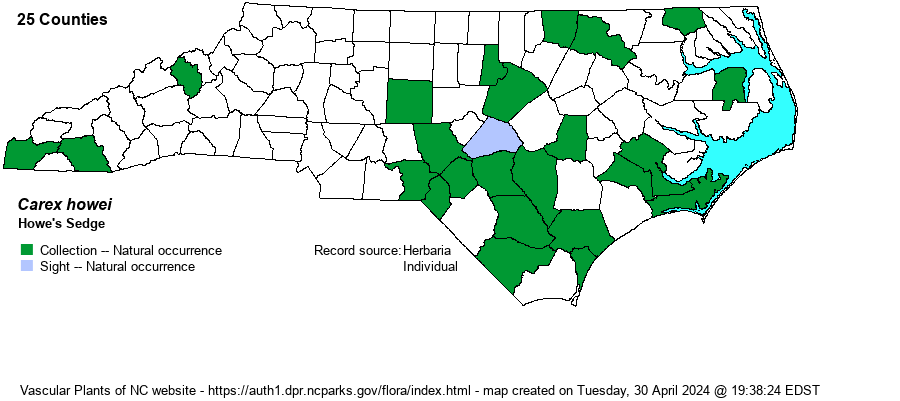| Section 5 » Family Cyperaceae |
Show/Hide Synonym
| taxonName | relationship | relatedTaxonName | relatedTaxonRefText | relComments |
|---|
|
|
|
|
|
|
|
| Carex howei | = | Carex atlantica var. capillacea | Gleason and Cronquist (1991) | | | Carex howei | = | Carex atlantica ssp. capillacea | Flora of North America (1993b, 1997, 2000, 2002a, 2002b, 2003a, 2004b, 2005, 2006a, 2006b, 2006c, 2007a, 2009, 2010) | | | Carex howei | = | Carex atlantica ssp. capillacea | Kartesz (1999) | | | Carex howei | = | Carex atlantica ssp. capillacea | | | | Carex howei | = | Carex atlantica ssp. capillacea | | | | Carex howei | = | Carex atlantica ssp. capillacea | Wunderlin & Hansen Flora of Florida (3) | | | Carex howei | > | Carex howei | Small (1933, 1938) | | | Carex howei | > | Carex mohriana | Small (1933, 1938) | | | Source: Weakley's Flora |
|
| Author | Mackenzie | |
| Distribution | Coastal Plain, Sandhills, and lower Piedmont; a few records in low elevations in the mountains. Several other specimens from the mountains need critical ID.
N.S. to MI and northwestern IN, south to central FL and eastern TX. | |
| Abundance | Frequent in the Sandhills and part of the southern Coastal Plain, less numerous in the northern Coastal Plain and eastern Piedmont; rare in the mountains. Often common where found, forming small but conspicuous tussocks. The website editors suggest a State Rank of S3S4. | |
| Habitat | Red Maple--Swamp Tupelo--cypress swamps, blackwater small stream swamps, montane seepages, bogs; usually growing in sphagnum moss. |
| Phenology | Flowering and fruiting May-June. | |
| Identification | Howe's Sedge is closely related to C. atlantica, but differs in its slenderer and shorter leaves and stems, and shorter perigynia (1.9-3 mm vs. 2.3-3.8 mm). | |
| Taxonomic Comments | Some authors include it within C. atlantica as var. or ssp. capillacea, but distinctions are almost always clear.
The genus Carex is the largest in North America, and among the largest in the world. In temperate and boreal regions, Carex is often the dominant or co-dominant ground layer in many habitats. Seeds (achenes) are valuable food for birds and small mammals, while foliage is used by birds and mammals to make nests and as food by mammals. Species of Carex often look vastly different from one another -- spikes erect vs. drooping, tiny inflorescence vs. whopping, culms leafy vs. naked, perigynia beaked vs. beakless, stems densely bunched vs. single, etc. The genus has been divided into many sections (or groups), based on shared characters; some taxonomists have suggested that these be different genera, but that proves unworkable (so far). All Carex share the feature of a perigynium (an outer covering) which completely surrounds the achene (seed). This covering may fit tightly or loosely (like a small bladder), depending on which group or species. Details of perigynia shape, ornamentation, presence and size of beak, number of striations (or veins) are all important ID features. In recent years Rob Naczi and colleagues have stressed the importance of arrangement of perigynia -- whether spiral (3+ ranks) or distichous (2-ranked) -- and have named a number of new species as well as split off some older synonyms. Therefore, RAB's (1968) key, excellent for its time, can only be used in a general way today. Members of some sections of Carex are difficult to key out (notably Ovales, Laxiflorae, Griseae); this is in part due to variation among individuals of a species, or failings of the key. FNA has drawings of most species and some species may be found in two or more places within a key, to acount for variability. New species to NC, and new to science(!), continue to be found in NC. | |
| Other Common Name(s) | Prickly Bog Sedge (but this is the most prevalent common name for C. atlantica). | |
| State Rank | [S3S4] | |
| Global Rank | G5T5? [G5?] | |
| State Status | | |
| US Status | | |
| USACE-agcp | | |
| USACE-emp | | |

